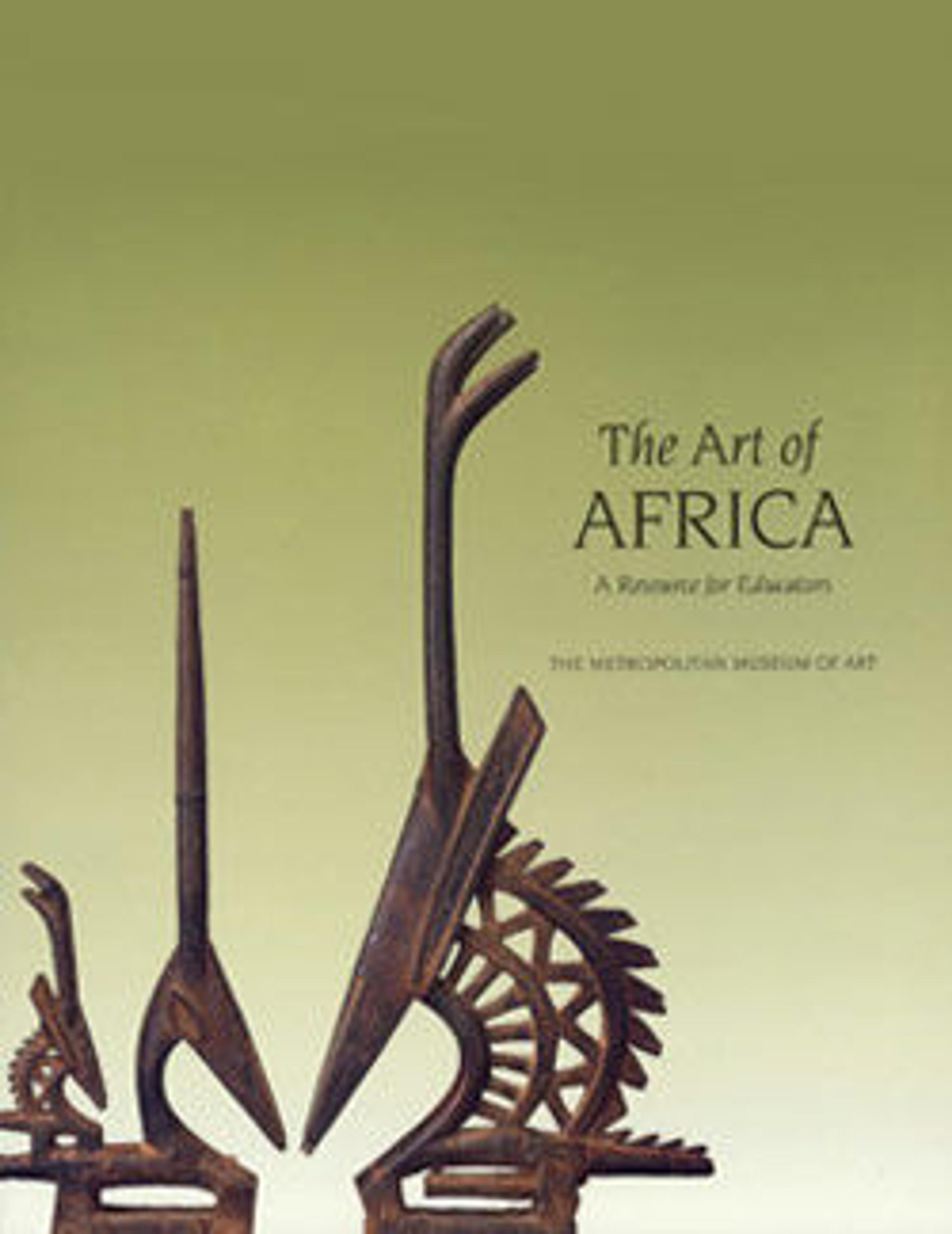D’mba (great mother) headdress
This colossal wooden headdress, measuring nearly four feet in height, is known as d'mba among the Baga peoples of the Guinea coast. D'mba's flat, pendant breasts are a symbol of motherhood and reveal the selfless dedication with which she has nursed numerous children to adulthood. Her coiffure consists of intricately braided rows of hair and a high crest down the center. This hairstyle is not a characteristic of the Baga, but rather one of the Fulbe people, who inhabit the Futa Jallon mountains, where the Baga ancestors once lived. The coiffure serves as a reminder to the Baga of their origins in the Futa Jallon. The face, neck, and breasts of the bust are decorated with linear patterns: a horizontal line from the cheek to the ear, a curved line from the ear along the jawline, a line connecting those two, all ending at a circular line that surrounds the entire face. Often on each cheek, just below the eyes, there are two short carved lines—the mark of Baga ethnicity. Embellishments are sometimes added as well, including painted wooden ornaments attached to the ear or pendants attached to the nasal septum.
Unlike masked representations from other African cultures, which may represent ethereal spirits or ancestors, d'mba is not a "spirit," but instead is loosely described by the Baga themselves as simply an "idea." D'mba is an abstraction of the ideal of the female role in Baga society. She is honored as the universal mother and is the vision of woman at the zenith of her power, beauty, and affective presence. Although d'mba is not a spiritual being in the Baga sense of the term, nor a deity, she is a being of undeniable spiritual power. The Baga conceive of her as a servant of sorts—inspiring young women with the strength to bear children and raise them to adulthood, inspiring young men to cooperative excellence in agriculture, and inspiring the ancestors to contribute toward the continuance of community well-being.
During performances, the massive headdress is worn with a costume of raffia and cloth. In the past, the d'mba masquerade was performed at least twice a year before the rainy seasons. She would also appear to dance at festive occasions such as marriages and funerals, and in honor of special guests. In contemporary Baga culture, d'mba performances have not been as widely embraced as in the past, so they are rarely witnessed today.
The origins of the d'mba headdress, like many other aspects of Baga material culture, remain the subject of conjecture. Most Baga elders suggest that d'mba was not brought by their nomadic ancestors, but rather created after their arrival to their current home in Guinea's coastal region. Interestingly enough, the cloth shawl worn by d'mba during performances, usually dark indigo or black, has always been cotton cloth imported from Europe, never of African manufacture. In fact, it seems that many Baga masquerades developed in the twentieth century use European factory printed cloth for the costume.
Unlike masked representations from other African cultures, which may represent ethereal spirits or ancestors, d'mba is not a "spirit," but instead is loosely described by the Baga themselves as simply an "idea." D'mba is an abstraction of the ideal of the female role in Baga society. She is honored as the universal mother and is the vision of woman at the zenith of her power, beauty, and affective presence. Although d'mba is not a spiritual being in the Baga sense of the term, nor a deity, she is a being of undeniable spiritual power. The Baga conceive of her as a servant of sorts—inspiring young women with the strength to bear children and raise them to adulthood, inspiring young men to cooperative excellence in agriculture, and inspiring the ancestors to contribute toward the continuance of community well-being.
During performances, the massive headdress is worn with a costume of raffia and cloth. In the past, the d'mba masquerade was performed at least twice a year before the rainy seasons. She would also appear to dance at festive occasions such as marriages and funerals, and in honor of special guests. In contemporary Baga culture, d'mba performances have not been as widely embraced as in the past, so they are rarely witnessed today.
The origins of the d'mba headdress, like many other aspects of Baga material culture, remain the subject of conjecture. Most Baga elders suggest that d'mba was not brought by their nomadic ancestors, but rather created after their arrival to their current home in Guinea's coastal region. Interestingly enough, the cloth shawl worn by d'mba during performances, usually dark indigo or black, has always been cotton cloth imported from Europe, never of African manufacture. In fact, it seems that many Baga masquerades developed in the twentieth century use European factory printed cloth for the costume.
Artwork Details
- Title:D’mba (great mother) headdress
- Artist:Baga artist
- Date:late 19th–first half of 20th century
- Geography:Guinea
- Culture:Baga
- Medium:Wood
- Dimensions:H. 46 1/2 in. × W. 13 3/4 in. × D. 23 in. (118.1 × 34.9 × 58.4 cm)
- Classification:Wood-Sculpture
- Credit Line:The Michael C. Rockefeller Memorial Collection, Bequest of Nelson A. Rockefeller, 1979
- Object Number:1979.206.17
- Curatorial Department: The Michael C. Rockefeller Wing
More Artwork
Research Resources
The Met provides unparalleled resources for research and welcomes an international community of students and scholars. The Met's Open Access API is where creators and researchers can connect to the The Met collection. Open Access data and public domain images are available for unrestricted commercial and noncommercial use without permission or fee.
To request images under copyright and other restrictions, please use this Image Request form.
Feedback
We continue to research and examine historical and cultural context for objects in The Met collection. If you have comments or questions about this object record, please contact us using the form below. The Museum looks forward to receiving your comments.
